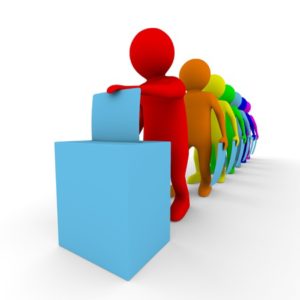By Dr. Ken Broda Bahm:

Politics matter, and not just when voting. The preference for your team and tribe, your perceptual filters, your values and priorities, as well as your sources for news and information are all going to depend on your political identity. But what does political identity mean these days? One thing that’s becoming increasingly clear: It means more than the binary distinctions between liberal and conservative, or between Democrat and Republican. Considering the varieties within each side, it turns out there are numerous subsets which are not arrayed on a clear spectrum.
The Pew Research group has devoted a lot of attention to clarifying these distinctions over the years, an effort I wrote about in a post from 2014, “Think Beyond Just Red and Blue.” Since then, of course, a lot has happened. And to keep up with the times, Pew has updated their categories. So it is time to take another look. In this post, I will comment a bit on the ways Pew’s process might inform the kinds of questions we ask in voir dire, and summarize Pew’s new classifications for political identity.
Discovering Political Type
The best way to understand Pew’s survey is to take the test yourself. Through a series of questions presenting two simple options and asking “which is closer” to your own view, the instrument identifies you with your closest political identity. For example, the first choice presents the following two options:
“The government today can’t afford to do much more to help the needy.”
One feature of these questions is that, lacking many options or a complicated scale-response, they’re very easy to answer. And that also makes them good questions for voir dire. The binary forced choice of which “which is closer” is a useful way of dividing the panel into areas of higher and lower risk based on your profile. It can be a little awkward to answer if it isn’t set up properly, but Pew offers an instruction that is also parallel to the set up for voir dire:
“You may find some of these questions are difficult to answer. For example, you may partly agree with both statements, or feel that neither quite describes your view. That’s OK. In those cases, pick the answer that comes closest to your view, even if it isn’t exactly right.”
Nine Kinds of Political Identity
In its latest edition, actually Pew’s seventh political typology over three decades, the organization looks at new kinds of fragmentations associated with Democratic losses and the rise of Donald Trump, noting that today, the divisions within the parties are as important as the divisions between them.
Pew’s descriptions lay out eight groups within the liberal-conservative universe as well as a ninth group that sits outside of both. Here is a quick summary.
Solid Liberals
-
- Largely white
- Well-educated (most are college graduates and nearly a third have a postgraduate degree)
- Express liberal attitudes on virtually every issue
- Highly likely to have acted in or contributed to protests against President Trump in the past year
Opportunity Democrats
-
- Agree with Solid Liberals on major issues
- But less affluent and less politically engaged
- Somewhat less liberal, both in their attitudes on issues and in their self-descriptions
- More likely than solid liberals to support corporations and large companies
- Believe that most people can get ahead if they are willing to work hard
Disaffected Democrats
-
- Disproportionately racial minority
- While holding positive feelings toward the Democratic Party and its leading figures, they are cynical about politics, government and the course of the country
- Financially stressed
- Supports activist government and the social safety net, but most say government is “wasteful and inefficient”
- Most believe their side has been losing in politics
- Fewer than half believe that voting gives them a say in how the government runs things
Devout and Diverse
-
- Faces higher financial hardships than Disaffected Democrats
- Most religiously-observant of all Democrat-leaning group
- Least politically engaged of all Democrat-leaning groups
- About a quarter lean Republican
- Critical of government regulation of business
Core Conservatives
-
- Only 13 percent of the public, but 43 percent of politically engaged Republicans
- Financially comfortable and male-dominated
- Overwhelmingly supports smaller government, lower corporate tax rates
- Believes in the fairness of the nation’s economic system
- Expresses a positive view of U.S. involvement in the global economy
Country-First Conservatives
-
- Older than other Republican-leaning groups
- Less educated than other Republican-leaning groups
- Unhappy with country’s course
- Focused on immigration and globalism (both being negative)
Market Skeptic Republicans
-
- Like other Republican-leaning groups but sharply diverging from others on financial issues
- Only about a third of Market Skeptic Republicans say banks and other financial institutions have a positive effect on the way things are going in the country
- Supports raising taxes on corporations and large businesses
- Believes that the economic system favors powerful interests
New Era Enterprisers
-
- Fundamentally optimistic about the state of the nation and its future
- More likely than any other typology group to say the next generation of Americans will have it better than people today.
- Younger and somewhat less overwhelmingly white than the other GOP-leaning groups
- Strongly pro-business
- Generally thinks that immigrants strengthen, rather than burden, the country
Bystanders
-
- Non-voters
- Non-affiliated with any party
- Not engaged by the political process
- Not interested or informed in political issues
Other Posts on Political Leanings:
- Adapt to Moral Division (Not Just Political Division)
- Know the Limits of Political Empathy
- Be Alert to Partisan Affect